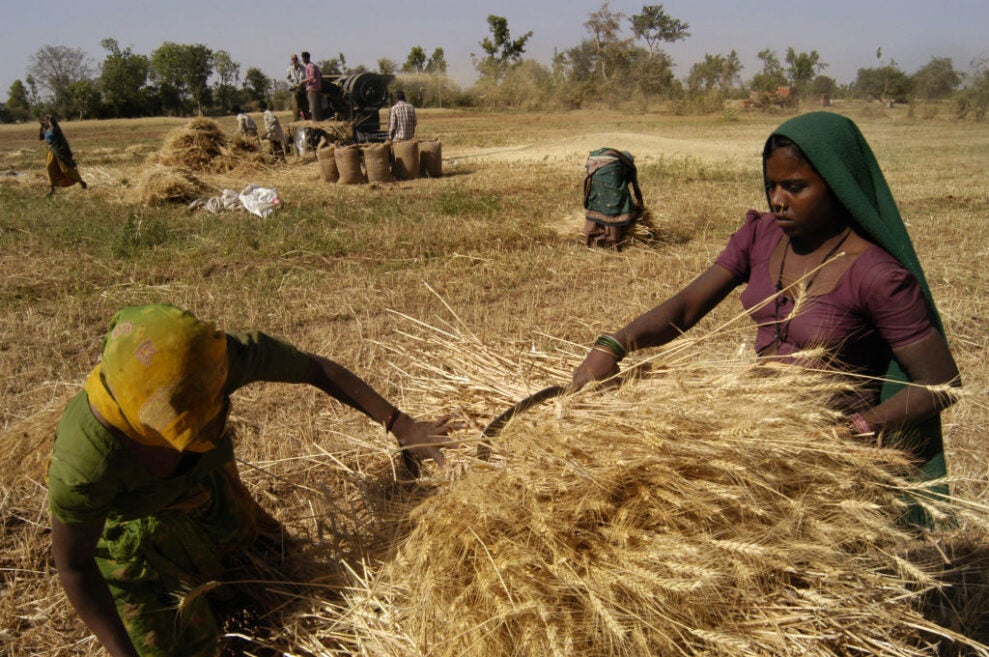
The role women and girls play in the world’s food systems is not reflected in their consumption of food or their financial situation. (Photo by: Rajeev Thakur/ IndiaPicture/Universal Images Group via Getty Images)
Although women are the bedrock of many food systems around the world, a deep gender divide persists. Women have fewer options to acquire food production assets and access opportunities and services. Globally, they continue to face legal and cultural barriers to access credit, land and other resources. For example, globally less than 15% of all landholders are women and yields for women farmers are 20–30% lower than for men. Women have fewer economic benefits from food value chains as they are both less connected and work predominantly in small-scale production.
Women’s and girls’ work as food producers is further complicated by disparities in access to information. Lower literacy levels and less access to technology such as radios or telephones leave many women and girls reliant on in-person information networks, which are more limited than those men have access to.
The Covid-19 pandemic has pushed more women deeper into hunger, exposing the fault lines of inequality in food systems internationally. According to the latest State of Food Security and Nutrition report, food insecurity is 10% higher among women, and 30% of women in the reproductive age in 2019 were affected by anaemia as result of malnutrition.
Why does the food system not work for women?
Women represent almost half of the total agricultural workforce in low-income countries and in most places it is they who are chiefly responsible for feeding their families. The nourishment of future generations lies in their hands – literally – yet our food systems do not work for them. Why?

US Tariffs are shifting - will you react or anticipate?
Don’t let policy changes catch you off guard. Stay proactive with real-time data and expert analysis.
By GlobalDataThe debates at the recent UN Food Summit in New York made it amply clear that it can no longer be ‘business as usual’ if we are to make food systems work for all, especially women.
To avoid the failures of more traditional approaches to empowering women, and to close the gender gap in global food systems, an evidence-based approach is critical to replace rhetoric with action.
Making it work for women – challenge stereotypes, focus on social relations
First, there is a need to challenge the inadvertent reinforcement of stereotypes that prevail through our food systems, from production to how the food is finally consumed.
A recent evidence paper published by the World Food Programme, together with the Food and Agriculture Organisation, the International Fund for Agricultural Development and CGIAR, showed that some food system programmes inadvertently perpetuate unequal gender stereotypes. For example, programmes globally have been known to involve women in nutrition projects in alignment with their traditional roles in food preparation, and in school feeding projects as voluntary workers in alignment with traditional unpaid care responsibilities.
Approaches are needed to address underlying social structures and create an enabling environment for women that allows them to take on transformative, empowering roles.
Second, we need to ensure that programmes involve men as well as women. Programmes targeting women and girls in isolation sometimes risk resentment and backlash from boys and men.
In Malawi, for instance, the provision of take-home rations for schoolgirls as a measure to ensure their active engagement in schooling stirred negative feelings of favouritism between boys and girls, which led to bullying. Meanwhile, in Ethiopia, there were unintended negative effects from targeting only women for food assistance, including inciting domestic violence because men were suspicious of women’s long absences when collecting food, a fact that was compounded if delays caused the women to return empty-handed. By contrast, approaches that focus on social relations, which include men and boys, are far more effective.
They also create scope for dialogue and renegotiation of gender norms. For example, in Ethiopia, Guatemala, Kyrgyzstan, Liberia, Nepal, Niger and Rwanda, a UN joint programme that involved both women and men in the design and development of programme activities created conditions where women were valued as producers and entrepreneurs and respected as leaders and decision makers in local food systems, on a level playing field with men. For example, in spite of the pandemic, women were able to achieve a 101% average increase in agricultural production and generate more than $530,000 from sales.
Walking the talk
For far too long our food systems have excluded women and girls who remain invisible, silent contributors to the way in which we feed the world. This needs to change. Our efforts need to ensure that women’s contributions to food systems are recognised and they are empowered to make choices that benefit not only their families and communities but all of society.



